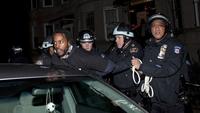-
Updated, expanded “Crime Scene Investigation” guide now available
Investigators and first responders can find the latest recommendations on crime scene investigations in the newly updated Crime Scene Investigation, A Guide for Law Enforcement.
-
-
Pentagon to review security clearance procedure, military base security
Defense Secretary Chuck Hagel acknowledged at a news conference on Wednesday that the procedure for granting security clearances will be looked at, and probably needed fixing, telling reporters that “a lot of red flags” about Alexis’s past behavior were missed. Among the questions will be whether more personal information — even short of information on a criminal conviction — should be looked at before a security clearance is granted, and whether security clearance reviews should be conducted more often. Hagel also announced that he had ordered a broad review of procedures at military bases around the world.
-
-
New study shows link between rates of gun ownership and homicides
A new study shows that U.S. states with higher estimated rates of gun ownership experience a higher number of firearms-related homicides. The study, covering thirty years (1981-2010) in all fifty states, found a “robust correlation” between estimated levels of gun ownership and actual gun homicides at the state level, even when controlling for factors typically associated with homicides. For each 1 percentage point increase in the prevalence of gun ownership, the state firearm homicide rate increases by 0.9 percent, the authors found.
-
-
Using math to track, predict criminals’ next move
One way to study criminal behavior and predict a criminal’s next move is by analyzing his or her movement. Several mathematical models have addressed this in detail, in particular, the UCLA “burglary hotspot” model. Mathematicians now propose a mathematical model that analyzes criminal movement in terms of a Lévy flight, a pattern in which criminals tend to move locally as well as in large leaps to other areas. This closely replicates daily human commute in big cities.
-
-
Suburban Chicago police cancels anti-terrorism training course after complaints
The police at the city of Lombard, Illinois, has cancelled a class on counterterrorism after the Chicago branch of a Muslim advocacy group complained that the Florida-based instructor and his teachings were blatantly anti-Muslim. The instructor has faced similar criticism in Florida. The course was to be taught through the North East Multi-Regional Training group, which trains Illinois police and corrections employees. The Illinois Law Enforcement Training and Standards Board said it was reviewing the course – titled “Islamic Awareness as a Counter-Terrorist Strategy” – and the materials used in it. The board said that instructor’s qualifications will also be reviewed.
-
-
Mathematical model informs gun policy debate
The relationship between the legal availability of guns and the firearm-related homicide rate has been a hot topic of debate in the United States for more than three decades now. Gun-control advocates argue that unrestricted gun availability promotes the occurrence of firearm-induced homicides. Gun-rights supporters have pointed out that gun possession can protect potential victims when attacked. A new paper presents a mathematical model – admittedly, with limited data – which offers a logical, detached approach to the gun-control debate.
-
-
Islamic group’s plan for a 9/11 "Million Muslim March" on Washington denounced
The American Muslim Political Action Committee (AMPAC) is organizing what it hopes would be a mass demonstration by American Muslims on 11 September in Washington, D.C. Critics called the demonstration ill-timed, if not downright offensive. Mainstream Muslim American groups describe group members as virulently anti-Semitic “truthers” who question al Qaeda’s responsibility for the 9/11 attacks. There is little chance a million people would show up for the march: AMPAC, based in Kansas City, Missouri, has just 57 supporters signed up for the 11 September event on Facebook.
-
-
Lawmakers, scientists question FBI’s investigation, conclusion in 2001 anthrax attacks

Twelve years after the fall 2001 anthrax attacks, and six years after the 2007 FBI’s determination that Bruce Ivins, a top government anthrax researcher at the U.S. Army Medical Research Institute of Infectious Diseases (USAMRIID), was the perpetrator of the attacks (Ivins died in 2008 of apparent suicide), lawmakers and USAMRIID scientists insist that the FBI’s conclusions are not supported by scientific evidence – indeed, that some basic scientific facts make the Bureau’s conclusions untenable.
-
-
Federal judge: NYPD stop-and-frisk policy violates 4th, 14th Amendments (updated)

In a scathing, 195-page decision, a federal judge repudiated one of the major pillars of Mayor Michael Bloomberg’s crime-fighting strategy, finding that the NYPD’s stop-and-frisk tactics violated the constitutional rights of minorities in New York. The NYPD stopped some 4.43 million between 2004 and mid-2012, with Blacks and Hispanics accounting for 88 percent of those stopped. The NYPD has explained the disparity by saying that it mirrored the disproportionate percentage of crimes committed by young minority men. Judge Shira A. Scheindlin, using harsh language, dismissed this rationale. “This might be a valid comparison if the people stopped were criminals,” Judge Scheindlin wrote, explaining that there was significant evidence that the people being stopped were not criminals. “To the contrary, nearly 90 percent of the people stopped are released without the officer finding any basis for a summons or arrest.” Rather, Judge Scheindlin found, the city had a “policy of targeting expressly identified racial groups for stops in general.” She added: “Targeting young black and Hispanic men for stops based on the alleged criminal conduct of other young black or Hispanic men violates bedrock principles of equality.” The judge ruled that the effectiveness of “stop and frisk” was irrelevant. “Many police practices may be useful for fighting crime — preventive detention or coerced confessions, for example — but because they are unconstitutional, they cannot be used, no matter how effective,” the ruling said.
-
-
FBI allowed informants to commit more than 5,600 crimes in a single year
Newly released documents show that the FBI allowed its informants to break the laws on more than 5,600 occasions in a single year. The Justice Department rules sets tight limits on when informants can engage in what the agency termed “otherwise illegal activity.” Under no circumstances can an agent authorize a violent crime, and the most serious crimes must be approved by federal prosecutors.
-
-
Interpol issues global alert following nine al Qaeda-linked prison breakouts
Interpol, in a statement issued from the organization’s headquarters in Lyon, France, urged law enforcement agencies around the world to show “increased vigilance,” following prison breakouts over the past nine month in nine countries, including Iraq (22 July), Libya (27 July), and Pakistan (31 July). More than 2,500 terrorists have escaped in these nine prison breakouts.
-
-
FBI terrorism unit investigates animal rights group after pheasant farm attack

An FBI Joint Terrorism Task Force has launched an investigating after an animal rights group announced on its Web site that its members cut open fencing around a and releasing more than a dozen pheasants from the aviary at Ash Grove Pheasant Farm and Orchard in Riverside, California. The incident took place 22 July.
-
-
The arithmetic of gun control and gun violence
The most comprehensive statistical study of gun violence in the United States – examining data going back to the First World War – finds that, in more common domestic and one-on-one crimes, reduced legal gun availability, if properly enforced, is likelier to lower deaths. In rare mass shootings, armed citizens might save lives if sufficiently trained to avoid accidentally shooting fleeing bystanders. The authors note, though, that key parts of their equations should be studied more closely: the fraction of offenders who illegally possess a gun, the statistical degree of protection provided by legal gun ownership, and the number of people who are legally carrying a gun when attacked. Comprehensive data in those areas, they say, could further aid the development and implementation of effective policies.
-
-
Research priorities for understanding public health aspects of gun-related violence
A new report from the Institute of Medicine (IOM) and National Research Council (NRC) proposes priorities for a research agenda to improve understanding of the public health aspects of gun-related violence. The committee which wrote the report said significant progress can be achieved in three to five years through a research program that addresses five high-priority areas: the characteristics of gun violence, risk and protective factors, prevention and other interventions, gun safety technology, and the influence of video games and other media.
-
-
Ukrainian man in U.K. court charged with anti-Muslim terrorism
Pavlo Lapshyn, a 25-year-old postgraduate student from Dnipropetrovsk, Ukraine, appeared in a Westminster, U.K. court Tuesday and charged with the terror-related April murder of an 82-year-old Mohammed Saleem as Saleem was walking home from a mosque. Lapshyn has also been charged with three additional offenses related to three explosions near mosques in Walsall, Wolverhampton, and Tipton.
-
More headlines
The long view
How Male Grievance Fuels Radicalization and Extremist Violence
Social extremism is evolving in reach and form. While traditional racial supremacy ideologies remain, contemporary movements are now often fueled by something more personal and emotionally resonant: male grievance.
